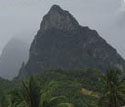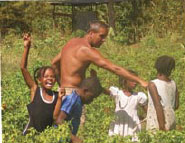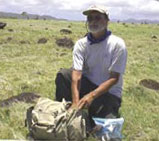
Photo by Daan Isendoorn
To the west stretched the vast expanse of the Caribbean Sea; to the north rose the magnificent Pitons, the symbol of St. Lucia. In April 2004, a pick-up truck deposited our field team at the foot of one of many hills that form a corrugated landscape along the island’s western shore. We would walk 3.5 km south to the Balembouche Estate while making a surface reconnaissance for pre-Columbian archaeological remains.
“The trek was the same all day: to the top of a hill, then to the bottom of an arroyo or stream channel, and then back to the top of a hill. By the time we reached Choiseul, about a kilometer to the south, we had already found eight archaeological sites, mostly on the hilltops.
Now in its third year, the project is a collaboration between myself, Drs. Corinne Hofman and Menno Hoogland, who are archaeology faculty at Leiden University in The Netherlands, and Eric Branford of the St. Lucia Archaeological and Historical Society. Branford also worked with the late Ripley Bullen of the Florida Museum in the 1960s and 70s. Initiated at the request of the Prime Minister, the project goal is to create a systematic record of pre-Columbian settlements on the island to assist with the management and protection of the island’s cultural patrimony.
This is the first comprehensive archaeological survey conducted in the Windward Islands of the southern Lesser Antilles. Already more than 50 previously unrecorded village sites and find spots (a place where a single artifact is found) have been identified, doubling the known number of sites. After decades of investigations by other archaeologists, and especially the systematic survey conducted by the Florida Museum team, no evidence for the earliest cultures in the West Indies has been found. Based on what is known from other islands, the logical conclusion is that St. Lucia was bypassed during the initial phase of settlement by peoples who originated in northeastern South America.
More than five centuries passed before the first colony was established on the island. Moreover, it is now clear that the island was far more intensively settled than previously recognized. Late period village sites (circa AD 1300) were found along river valleys up to 10 km from the coast. The evidence promises to completely revise our understanding of the earliest history of St. Lucia and the Windward Islands.
William Keegan, Ph.D. is Curator of Caribbean Archaeology at the Florida Museum of Natural History. His research focuses on the native peoples of the West Indies prior to the arrival of Europeans, with an emphasis on social and economic relations. Since 1978, he has directed archaeological research projects throughout the West Indies, including the Bahamas, Turks and Caicos, Grand Cayman, Cuba, Haiti, Dominican Republic, Jamaica, Grenada, Trinidad and St. Lucia.
Learn more about the Caribbean Archaeology Collection at the Florida Museum.

